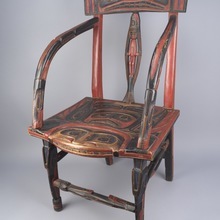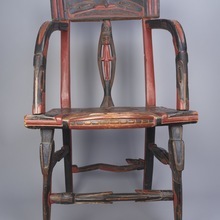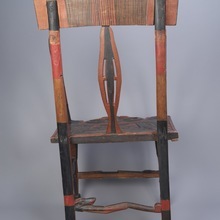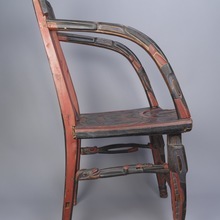Chief's Chair
MOA: University of British Columbia
3261/120
Chief's chair, fully carved with animal motifs on most of its components. The chair has a deeply carved seat with a figure that likely represents a sculpin, characterized by a broad, toothed mouth, a horn-like spine on either side of the head, a series of spines along each fin, and the body with tail fin. Its mouth is centred on the bowed front edge of the seat, the facial features are carved on the seat’s upper front surface, and the fins and body (portrayed as a face) are arranged over the remaining seat in a split, bilateral fashion. It is painted in black and red, with some blue-pigmented areas and diagonal parallel hatching; other areas are left unpainted. The carved upper panel on the chair’s back depicts a face with black eyebrows and broad, toothed mouth. Connecting the panel to the seat is a vertical splat carved in the form of a fish and enclosing a human figure. The chair’s curved arms represent wolves, their heads facing downward and limbs folded. Also distinctive are the front two chair legs, which are carved in the form of downward-facing, supernatural raven heads; these feature blue-pigmented eye sockets and teeth, black beaks and eyes, and red lip-line and nostrils. The rear legs and stiles are painted but not carved. The four carved stretchers between the legs are made to represent different creatures: a killer whale with dorsal and pectoral fins folded back along its body and tail flukes folded up; a bear-like figure holding a long fish with ridged body; a wolf-like figure with extremely long “fingers”; and a figure with a beaver-like head, characterized by prominent incisors.
-
Iconographic Meaning
Ocean-related imagery: sea monster like sculpin, sea raven, bear holding onto a serpent or eel, sea-wolf, fish-like, halibut or oolichan-like being. Man may be in spirit mode transitioning and travelling with these beings through the ocean and into the house of Kumugwe', the Chief of the Sea [Ian ńusí Reid - Heiltsuk, 2019].
-
History Of Use
This fully carved chair may have functioned in the same way as did older styles of Northwest Coast chiefs’ seats, or settees that were bench-like and placed directly on the floor, without legs. Here, creatures from the land, sea, and supernatural realms of the Heiltsuk world transform the otherwise European-style armchair, presumably befitting the status of the high-ranking individual who would occupy it.
-
Narrative
Purchased by the donor through a Heffel Gallery auction in 2016. The auction provenance said the chair was once in the Pitt Rivers collection in England, then in the Roy G. Cole collection in Ontario, until it was sold at Sotheby's in 2000. The chair is made in a style imitating, or influenced by, the overall form of early-nineteenth-century English Regency furniture. A brass plaque mounted on the rear of the seat (probably from the first collector) read “Chair, Hyda Indians, NW Coast of America”. While some of its carved elements may suggest an attribution to the renowned Heiltsuk (Haíɫzaqv) artist and chief, Captain Richard Carpenter (1841-1931), the chair is more closely aligned to the work of ‘Qa’aít, Chief Robert Bell (1859-1904). Comparative research with stylistically similar carvings, both documented and unattributed, points to distinctive characteristics of Bell’s style, including his stretched, human-like animal figures with long fingers [Duffek, 2019].
- Type of Item chair
- Culture Heiltsuk
- Material maple wood, paint, metal
- Measurements height 96.5 cm, width 57.0 cm, depth 62.5 cm (overall)
- Creator Chief Robert Bell
- Previous Owner Elspeth McConnell
- Received from Elspeth McConnell
- Made in Bella Bella, 'Qvuqvai
- Creation Date between 1880 and 1900
- Ownership Date before April 12, 2018
- Acquisition Date on April 12, 2018
- Condition fair
- Accession Number 3261/0120



